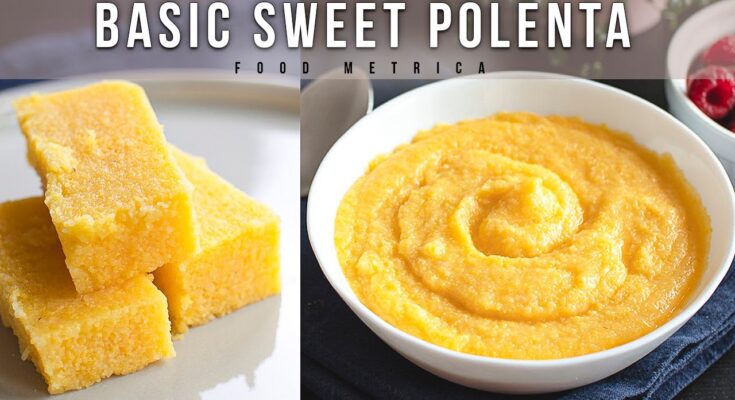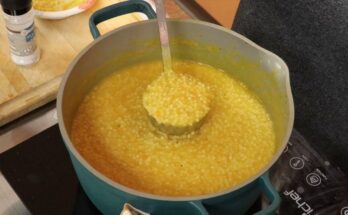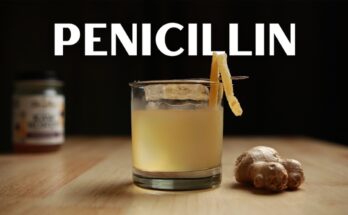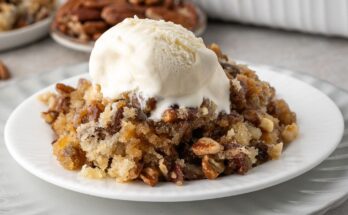Polenta Recipe: Polenta is a classic Italian dish made from ground cornmeal. Once considered a peasant food, it has become a staple in global cuisine for its simplicity and versatility.
Traditionally served creamy or allowed to solidify and then baked or fried, polenta is a canvas for countless culinary creations.
History and Origins of Polenta
Polenta has its roots in Northern Italy, where it was a staple for centuries. Originally made with grains like millet and spelt before corn was introduced from the Americas, polenta was a nourishing, affordable food for rural communities. Today, it remains a cornerstone of Italian gastronomy.
Why Polenta is a Versatile Dish
Polenta’s adaptability is unmatched. Whether served as a creamy base for rich stews, cut into slices and grilled, or baked into crispy fries, it can be reimagined endlessly. Its mild flavor complements savory and sweet toppings, making it a favorite for chefs and home cooks alike.
Ingredients for Making Polenta
Core Ingredients
- Cornmeal: Coarse or medium-grind is ideal for polenta.
- Water or Broth: Acts as the cooking liquid and imparts flavor.
- Salt: Enhances the natural sweetness of the corn.
- Butter or Olive Oil: Adds richness and creaminess.
- Cheese (Optional): Parmesan or Pecorino for an added touch of luxury.
Optional Add-ins for Flavor
- Fresh herbs like thyme or rosemary.
- Garlic for a savory twist.
- Cream or milk for a richer texture.
- Spices like paprika or black pepper to elevate the flavor.
Tools and Equipment You’ll Need
Essential Cooking Tools
- Medium-Sized Pot: A thick-bottomed pot prevents sticking and ensures even cooking.
- Whisk or Wooden Spoon: For continuous stirring to avoid lumps.
- Measuring Cups: Precision matters when measuring liquids and cornmeal.
Substitutions for Common Kitchen Tools
Don’t have a whisk? A sturdy spatula works too! If you lack a thick-bottomed pot, double up on lower heat and stir more frequently to prevent burning.
Preparing Polenta – Step-by-Step Guide
Step 1: Measuring Your Ingredients
Start by determining your serving size. A standard ratio is 1 cup of polenta to 4 cups of liquid. Adjust for more servings but maintain this ratio for a creamy consistency.
Step 2: Heating the Liquid
Bring water or broth to a gentle boil in your pot. Add a pinch of salt to season the liquid, as it will infuse the polenta with flavor right from the start.
Step 3: Adding the Polenta Gradually
Slowly pour the cornmeal into the boiling liquid while whisking constantly. This prevents clumping and ensures a smooth texture. Once incorporated, reduce the heat to a simmer.
Cooking Techniques for Perfect Polenta
Stirring and Consistency
Consistency is key! Stir frequently to prevent lumps and sticking. Polenta should thicken gradually over 30-40 minutes, developing a creamy, smooth texture.
Avoiding Common Mistakes
Avoid using instant polenta if aiming for authentic flavor. Also, don’t skip stirring—it’s crucial for even cooking and avoiding a burnt bottom.
Types of Polenta Recipes
Creamy Polenta
Creamy polenta is the most traditional and comforting version. It’s made by simmering cornmeal in a mix of water or broth until thickened, then finishing with butter, cheese, or cream for a velvety texture. It’s the perfect base for hearty dishes like braised short ribs, roasted vegetables, or a drizzle of olive oil.
To make creamy polenta:
- Follow the basic recipe, ensuring constant stirring.
- Add a generous knob of butter and grated Parmesan in the last 5 minutes of cooking.
- Serve warm with your favorite toppings.
Fried Polenta
Fried polenta is a fantastic way to use leftovers. Once the cooked polenta cools and solidifies, it can be cut into slices or shapes and fried until golden and crispy. These fried pieces make an excellent snack, appetizer, or side dish.
Steps to make fried polenta:
- Pour freshly cooked polenta into a greased dish and let it cool until firm.
- Slice into rectangles, circles, or wedges.
- Fry in hot oil or butter until crisp on the outside and tender on the inside.
Baked Polenta
Baked polenta offers a hands-off method that’s great for gatherings. Spread a layer of prepared polenta in a baking dish, top with marinara sauce, cheese, or other toppings, and bake until bubbly.
To make baked polenta:
- Spread creamy polenta evenly in a greased baking dish.
- Add toppings like sautéed mushrooms, marinara, and mozzarella.
- Bake at 375°F (190°C) for 25–30 minutes until golden.
Serving Suggestions and Pairings
Best Toppings for Polenta
Polenta is a blank canvas for endless toppings:
- Savory: Sautéed greens, roasted mushrooms, or rich tomato-based sauces.
- Protein-Packed: Grilled chicken, pan-seared fish, or stewed meats.
- Cheesy: A sprinkle of feta, crumbled goat cheese, or melted mozzarella.
- Sweet: Honey, nuts, or fruit compote for a dessert twist.
Polenta as a Side Dish or Main Course
As a side, creamy polenta pairs beautifully with saucy dishes like beef stew or vegetable ratatouille. For a main, consider topping it with hearty proteins, roasted vegetables, or a poached egg for a complete meal.
Tips for Polenta Perfection
Adjusting Consistency
Polenta consistency can vary based on personal preference:
- For creamy polenta, add more liquid during cooking and stir often.
- For firmer polenta, reduce liquid and cook longer to allow more evaporation.
If your polenta thickens too much, add a splash of warm water or broth to loosen it.
Storing and Reheating Leftover Polenta
- Storage: Transfer leftovers to an airtight container. It will firm up as it cools.
- Reheating: Add a splash of water or broth and reheat on the stove, stirring to restore the creamy texture.
Nutritional Benefits of Polenta
Caloric Breakdown
Polenta is low in fat and calories, making it a healthful addition to most diets. A single cup of cooked polenta has about 150–200 calories, depending on added ingredients.
Vitamins and Minerals in Polenta
Cornmeal is a good source of essential nutrients, including:
- Iron: Supports healthy blood cells.
- Vitamin A: Promotes eye health.
- Magnesium: Beneficial for muscle and nerve function.
Creative Twists on Traditional Polenta
Polenta Pizza Crust
Swap out traditional pizza dough for a polenta base! Spread thick polenta on a baking sheet, let it cool, and add toppings like tomato sauce, cheese, and veggies. Bake until the edges crisp up for a gluten-free pizza alternative.
Polenta Cakes
Transform leftover polenta into cakes by forming patties and pan-searing them. Serve with a dollop of sour cream, fresh salsa, or a poached egg for a unique brunch option.
Common Mistakes to Avoid When Making Polenta
Overcooking
Polenta can turn gummy if overcooked. To avoid this, stick to the recommended cooking time and remove from heat once the grains are tender and creamy.
Using the Wrong Type of Polenta
Instant or fine-ground polenta cooks quickly but lacks the texture and flavor of traditional coarse or medium-grind varieties. Always check the label for the desired grind.
Regional Variations of Polenta
Italian Regional Polenta Dishes
In Lombardy, polenta is often paired with rich stews like osso buco. In Veneto, creamy polenta is served with sautéed seafood. Each region has its unique twist, showcasing local ingredients and traditions.
Global Adaptations
Beyond Italy, polenta has inspired dishes like the American cornbread, Romanian mamaliga, and Brazilian angu. These variations highlight the universal appeal of cornmeal-based recipes.
Sustainability and Polenta
Polenta as an Eco-Friendly Food Choice
Cornmeal requires fewer resources to produce compared to many other grains, making polenta an eco-friendly staple. Supporting organic and local cornmeal producers further reduces environmental impact.
Sustainable Farming of Cornmeal
Look for stone-ground or non-GMO cornmeal from sustainable farms to ensure you’re contributing to eco-conscious practices.
FAQs About Polenta Recipe
1. What is polenta made of?
Polenta is traditionally made from coarsely ground yellow cornmeal, boiled in water or broth to create a creamy, porridge-like dish. It can also be cooled and solidified for grilling, frying, or baking.
2. Is polenta gluten-free?
Yes, polenta is naturally gluten-free, as it is made from cornmeal. Always check the packaging to ensure no cross-contamination during processing.
3. What are the best toppings for polenta?
Polenta pairs well with a variety of toppings, such as sautéed vegetables, roasted meats, mushroom ragout, cheese, or a drizzle of olive oil.
4. Can I make polenta ahead of time?
Yes, you can prepare polenta in advance. Once cooked, it can be refrigerated in a solidified form and reheated by grilling, frying, or baking.
5. How do I store leftover polenta?
To store leftovers, place the polenta in an airtight container and refrigerate for up to three days. Reheat with a splash of water or broth to restore its creamy consistency.
6. Can polenta be frozen?
Yes, polenta can be frozen. Allow it to cool, then cut into slices and freeze in an airtight container for up to three months.
7. Is polenta the same as grits?
Polenta and grits are similar but not the same. Polenta is made from yellow cornmeal, while grits are typically made from white hominy. The texture and flavor may vary slightly.
Conclusion
Polenta is a timeless, versatile dish that’s both easy to prepare and endlessly customizable. Whether you enjoy it creamy, fried, or baked, this simple recipe can be adapted to suit any occasion or flavor profile. With the tips and techniques shared here, you’re ready to create your own polenta masterpiece. So, grab your ingredients and give this comforting classic a try—you won’t be disappointed!



